Tiffany Lamps Fetch
Astronomical Prices
by
Bob Brooke
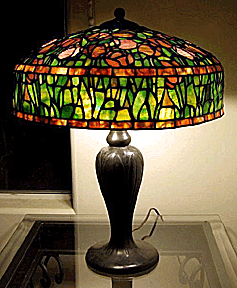 With
Tiffany lamps fetching astronomical prices, how can a buyer know that a
lamp is an original Tiffany? According to Alistair Duncan, Tiffany
expert and author of the book Louis Comfort Tiffany, the glass is
the identifying characteristic. "A lamp’s style or signature
isn't the only criteria from which to judge it," she said.
"Some models only had the base signed, some the shades. But
provenance, or a history of its owners, is probably more important.
Though some lamps may come onto the market from someone’s attic and,
therefore, not have a provenance, in most cases, the first thing I try
to establish is a provenance." With
Tiffany lamps fetching astronomical prices, how can a buyer know that a
lamp is an original Tiffany? According to Alistair Duncan, Tiffany
expert and author of the book Louis Comfort Tiffany, the glass is
the identifying characteristic. "A lamp’s style or signature
isn't the only criteria from which to judge it," she said.
"Some models only had the base signed, some the shades. But
provenance, or a history of its owners, is probably more important.
Though some lamps may come onto the market from someone’s attic and,
therefore, not have a provenance, in most cases, the first thing I try
to establish is a provenance."
Tiffany’s magnificent lamps were an instant
commercial success and won prizes and awards wherever they were
displayed. Thus, his designs were emulated by several American
companies, including Handel, the Pairpoint Corporation and Quezal. While
Handel and Pairpoint concentrated upon creating innovative lampshades,
often, but not always, in the style of Tiffany, Quezal helped to satisfy
the increasing demand for the iridescent glassware popularized by
Tiffany in America.
The name "Tiffany" has become a
generic term for windows, lamps, and glass of--or imitating--the period.
However, there were many other firms in the U.S. and in Europe doing
similar and in many cases nearly identical work. This has lead to a
great deal of confusion, and much work by others is sold as
"Tiffany," often with false "Tiffany" signatures
added to it.
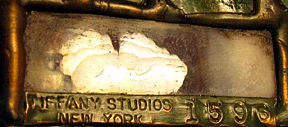 It’s important to note that much of the
genuine work of L. C. Tiffany and Tiffany studios was NOT marked or
signed in any way. However, it’s often easy to forge Tiffany
signatures on similar-looking period or reproduction items. Many genuine
Tiffany pieces that weren’t signed originally have probably had forged
signatures added to them to increase their worth and make them easier to
sell, as well. It’s important to note that much of the
genuine work of L. C. Tiffany and Tiffany studios was NOT marked or
signed in any way. However, it’s often easy to forge Tiffany
signatures on similar-looking period or reproduction items. Many genuine
Tiffany pieces that weren’t signed originally have probably had forged
signatures added to them to increase their worth and make them easier to
sell, as well.
Reproductions are quite common. Currently
almost all of Tiffany Studios' bronze lamp bases are being reproduced.
And probably almost anything Tiffany ever made that’s pictured in
books about Tiffany is now being reproduced or forged--or could be.
Names of modern reproducers include several easily confused with
original old names--Dale Tiffany, TiffaMini, Quoizel, Handale--and there’s
even a firm selling to large lighting showrooms under the name
"Tiffany Studios", though they may have been forced to desist
using that name.
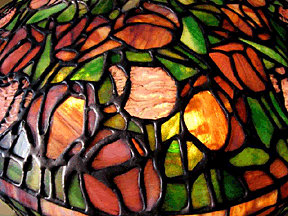 A Tiffany reproduction is a lamp made by
another who reproduced the same design as Tiffany Studios. They sell for
significantly less than an original Tiffany lamp, but are essentially
made to the same quality standards in most cases. The price range for
Tiffany reproductions is generally between $500 to $5000 in the U.S.
Those of better quality are generally made from Bullseye, Oceana,
Uroboros, Kokomo, Stipple and other glasses that meet this criteria. A Tiffany reproduction is a lamp made by
another who reproduced the same design as Tiffany Studios. They sell for
significantly less than an original Tiffany lamp, but are essentially
made to the same quality standards in most cases. The price range for
Tiffany reproductions is generally between $500 to $5000 in the U.S.
Those of better quality are generally made from Bullseye, Oceana,
Uroboros, Kokomo, Stipple and other glasses that meet this criteria.
Artistic Glass of Atlanta, Georgia, for
example, offers a wide selection of Tiffany reproduction lamps in its
showroom. Tiffany lighting has been expanded in application since the
time when Tiffany created the first ones in 1899. They are now available
in hanging, ceiling flush mounts, fan mounts, chandelier, wall sconces
and small accent lamps. They are also available in all the traditional
functions as well such as table and floor lamps.
Tiffany-Style Lamps
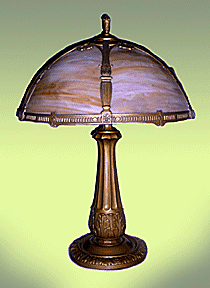 A Tiffany-style lamp, on the other hand, A "Tiffany style"
lamp is a lamp made by the same technique as Tiffany studios, but are
totally new designs crafted by different artists. Often they will
resemble a Tiffany design, but have subtle differences. Tiffany style
lamps will begin at the price of about $100 and go to as much as $5000
depending on their quality and size.
A Tiffany-style lamp, on the other hand, A "Tiffany style"
lamp is a lamp made by the same technique as Tiffany studios, but are
totally new designs crafted by different artists. Often they will
resemble a Tiffany design, but have subtle differences. Tiffany style
lamps will begin at the price of about $100 and go to as much as $5000
depending on their quality and size.
"The market for Tiffany lamps is very
bright, even luminescent," said Duncan. "It’s a very strong
market which has suddenly turned up another notch. In fact, it has never
been stronger."
Today original Tiffany lamps are sought highly
by collectors. A "Magnolia" auctioned in 1985 sold for
$528,000. One auctioned recently, sold for $990,000. A
"Zinnia" recently sold for over a million.
"A ‘Lotus’ sold at auction last
December for $2.8 million, the highest amount for public sale," she
said. "But there have been quite a few lamps reaching the
seven-figure level at auction. That very ‘Lotus’ lamp I sold
privately in 1994 in Japan for $4.6 million from the owner here in New
York, who had originally had purchased two of them. The first one was
sold at Sotheby’s a year earlier for $1.1 million. The second came
back and was sold at Christie’s.
"For the first time in my memory, which
goes back to 1977, the highest price for a lamp at auction was $22,000
in Chicago," Duncan added. "and went from there very quickly
to six figures. Every three or four months there’s a Wisteria for sale
and the price is always in the high $100,000 or $200,000."
The Market for Tiffany Lamps
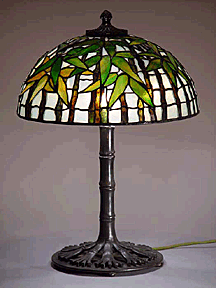 This simple tale illustrates just how volatile the Tiffany lamp market
has become: As prices go up and up, objects go round and round, often
with bewildering speed. A southern client sent a photograph of a Tiffany
lamp to Christie's and, following an exchange of correspondence, the
lamp arrived in New York where, on inspection, it was found to be a
modern reproduction. The owner was notified and the lamp returned. It
was immediately placed in a local auction where it was purchased and
sent by the next owner--to Christie's. It was again returned. Over the
next three months the piece is now known to have changed hands three
further times, making its way, finally, into a Tiffany collection in
California just in time to be included in a shipment--to Christie's. The
entire episode, from the time the first photograph of the lamp was sent
to the time that the lamp made its third visit to New York took only
seven months, highlighting the frantic pace at which the Tiffany market
can operate.
This simple tale illustrates just how volatile the Tiffany lamp market
has become: As prices go up and up, objects go round and round, often
with bewildering speed. A southern client sent a photograph of a Tiffany
lamp to Christie's and, following an exchange of correspondence, the
lamp arrived in New York where, on inspection, it was found to be a
modern reproduction. The owner was notified and the lamp returned. It
was immediately placed in a local auction where it was purchased and
sent by the next owner--to Christie's. It was again returned. Over the
next three months the piece is now known to have changed hands three
further times, making its way, finally, into a Tiffany collection in
California just in time to be included in a shipment--to Christie's. The
entire episode, from the time the first photograph of the lamp was sent
to the time that the lamp made its third visit to New York took only
seven months, highlighting the frantic pace at which the Tiffany market
can operate.
What’s astonishing, noted Duncan, is that for
the first time, demand exceeds supply. "There were always lots of
lamps out there," she said. "but a collector in Nagoya, Japan,
has a opened a private museum, the Louis C. Tiffany Museum, in 1994. He
has vacuumed up the best of everything. The catalog for the museum,
along, sells at the Metropolitan Museum of Art in New York for $145.
Unfortunately, for most collectors, prices are prohibitive now."
Tiffany retired in 1918, but he kept a watchful
eye on the company. Nash carried on the business, but his later work,
fighting a rearguard action against Art Deco, wasn’t of the same
quality. In 1928, L.C. Tiffany severed all connection with the firm,
withdrawing permission to use his name.
By his vision and energy, Louis C. Tiffany
succeeded in blending classical motifs with bold new techniques in
glassmaking to create a distinctive American art form. The demand for
Tiffany lamps among today's collectors attests to the lasting value of
his work.
Read
more about Tiffany and his lamps.
To read
more of my articles, please
visit
my Web site.
<
Back to Antiques Articles Next Article >
|
